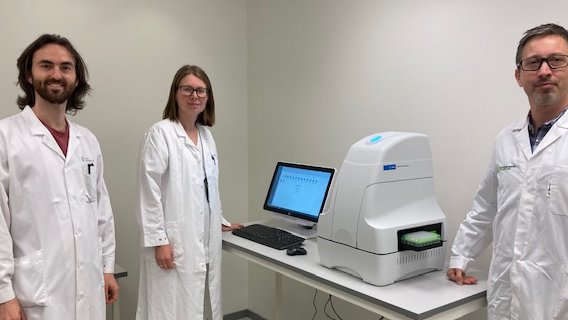Unravelling the mysteries of cancer cells
A new instrument in Oslo Cancer Cluster Incubator will help researchers to learn how cells function so novel cancer treatments can be developed.
The instrument Seahorse was recently donated by Radiumhospitalets Legater to Oslo University Hospital’s Department for Cell Therapy and will be available for all researchers in Oslo Cancer Cluster Incubator.
“The Department of Cell Therapy is in the international forefront in their field of research. Radiumhospitalets Legater is proud to support their endeavor with this important instrument,” says Jan Vincents Johannessen, Head of Radiumhospitalets Legater.
The instrument can make important measurements inside cells to understand the mechanisms of many diseases, including cancer. The data is collected from live cells in real-time, which will give researchers novel insights into cell metabolism.
“A Seahorse instrument measures the metabolism of cells, their respiration and energy production in real time and at high throughput,” said Dr. Else Marit Inderberg, senior scientist at the Department of Cell Therapy, Oslo University Hospital.
Metabolic reprogramming is emerging as a critical target in therapeutic intervention, for example in the development of new cancer treatments, which is why this instrument is so important for academics and companies in the cancer field.
“Metabolism plays a central part in the evolution of cancer cells and also in the efficacy of immune cells that infiltrates tumour cells. A tool that permits measuring the different metabolism modalities of both cancer cells and immune cells is an invaluable asset in the development of new therapeutic approaches,” Dr. Inderberg continued. “We will use the instrument to both assess the cancer cells as target cells and to optimize our immune cells used in therapy. This may help to provide clues about why some patients in clinical trials respond to different types of treatments and some do not.”
The instrument is placed in one of the laboratories in Oslo Cancer Cluster Incubator, where both academic researchers and researchers from private companies can access it as they develop new cancer treatments. Oslo Cancer Cluster Incubator, by laboratory manager Janne Nestvold, made the physical space available and facilitated the procurement of the instrument, including user training.
“The Seahorse instrument will be a useful cell analysis tool in the laboratory instrument portfolio to support researchers in the development of next generation cancer therapies,” commented Nestvold.
The Seahorse is not the type of instrument you would find in just any laboratory.
“There are only around ten instruments of this kind in Norway,” said Erik Brodin from Matriks AS, a company that offers solutions, instruments and support to laboratories across Norway. “Each is worth approximately NOK 2 million.”
Brodin has given training and instructions to a couple of the researchers in the Incubator. These two researchers will pass on their knowledge to the rest of the team.
Oslo Cancer Cluster Incubator are currently in the process of expanding the cell laboratories due to high demand for these kinds of facilities. Meeting rooms are now being converted into laboratories to meet the growing need from tenants.












